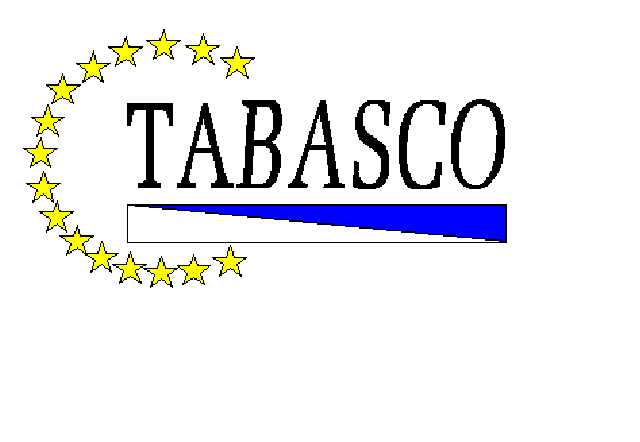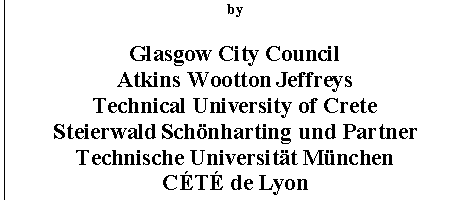

Telematics Applications in BAvaria, SCotland and Others
Project number TR1054
Deliverable number 8.2
Deliverable type: Internal
Deliverable due date: September 1997
Date: September 1997

Workpackage number: 8
Workpackage title: Urban Integrated Traffic Control
Nature of deliverable: Internal Report

Telematics Applications in BAvaria, SCotland and Others
Project number TR1054
Deliverable number 8.2
Deliverable type: Internal
Deliverable due date: September 1997
Date: September 1997
Urban Integrated Traffic Control
Implementation Strategies
Workpackage number: 8
Workpackage title: Urban Integrated Traffic Control
Nature of deliverable: Internal Report
by
Tom McLean, Glasgow City Council
Colin Brader, Atkins Wootton Jeffreys
Christina Diakaki, Technical University of Crete
Markos Papageorgiou, Technical University of Crete
Stefan Hangleiter, Steierwald Schönharting und Partner
Maria Tsavachidis, Technische Universität München
Christophe Damas, CÉTÉ de Lyon
ABSTRACT
TABASCO Workpackage eight “Urban Integrated Traffic Control” aims to develop, validate, stimulate and demonstrate integrated traffic control, harmonising motorway and UTC control techniques across the interface between inter-urban and urban environments. Workpackage eight addresses the technical performance of integrated control techniques, their network impacts and socio-economic effects, legal/institutional questions and user acceptability.
This report presents the development of integrated control software architecture in the three demonstration sites of Glasgow, Munich and Lyon. In Munich this has involved the integration of AIDA and VARIA as well as defining links between the STRAMA and NEMO network assessment tools. In Glasgow a context for integration exists with the NADICS control centre. Here the control strategies developed off line using the METACOR model will link two systems that reside within the same control centre and share the same communication protocol. Within Lyon Control strategies have been produced and tested by the INTEGRATION model to link the PASCAL and CORALLY control centres.
In Glasgow and Lyon control strategies are developed off line and implemented automatically when the pre requisite traffic conditions are found to exist. In Munich control strategies are also developed off line but implementation is only undertaken if environmental and traffic impact criteria are satisfied.
The detailed control processes and implementation architecture defined herein will lead to demonstration field trials at each city during Summer/Autumn 1997.
Keyword list: Control, Integration, Model, Glasgow, Munich, Lyon
The primary objective of Work Package 8, Urban Integrated Traffic Control, of the TABASCO project is to develop, validate, simulate and subsequently demonstrate integrated traffic control, harmonising motorway and UTC control techniques across the interface between inter-urban and urban environments. Such integrated control is designed to achieve greater network efficiency by improved response to recurrent and non-recurrent events, including road works and incidents, and to better inform drivers of such conditions. WP8 is designed to address the technical performance of integrated control techniques, their network impacts and socio-economic effects, legal/institutional questions and the user acceptability of the control measures adopted. The work package involves demonstrations in Glasgow, Lyon and Munich. Belfast and Edinburgh are active follower sites.
This report presents the development of integrated control software architecture in Munich, Glasgow and Lyon based upon validated control models, TABASCO deliverable 8.1.
The report has built upon the model definition and verification detailed in deliverable 8.1 by defining the considerations both physical and institutional to be made when arriving at acceptable control strategies. From this base control strategies are developed that integrate the motorway and urban networks using VMS and UTC. In Munich this has involved the integration of AIDA and VARIA as well as defining links between the STRAMA and NEMO network assessment tools. In Glasgow a context for integration exists with the NADICS control centre. Here the control strategies developed off line using the METACOR model will link two systems that reside within the same control centre and share the same communication protocol. Within Lyon Control strategies have been produced and tested by the INTEGRATION model to link the PASCAL and CORALLY control centres.
In Glasgow and Lyon control strategies are developed off line and implemented automatically when the pre requisite traffic conditions are found to exist. In Munich control strategies are also developed off line but implementation is only undertaken if environmental and traffic impact criteria are satisfied.
Traffic problems in cities are commonly peak hour, implying tidal flow. The strategies developed in Glasgow and Munich reflect this tidality looking to divert to parallel alternatives. Lyon are looking to a network based solution that has raised its own interesting problems related to acceptable and non acceptable routes which can accept diverting traffic.
The detailed control processes and implementation architecture defined herein will lead to demonstration field trials at each city during Summer/Autumn 1997.
Table of Contents
1. INTRODUCTION
1.1 The TABASCO Context
1.2 Control Models in Context
1.3 The Test Sites
1.4 Form of Report
2. GENERAL CONSIDERATIONS
2.1 Introduction
2.2 Munich
- The Control Task
- Urban Network
- Motorway Network
2.3 Glasgow
- The Demonstration Site
- The Control Task
- Traffic Lights Settings
- VMS Settings
2.4 Lyon
- Traffic control objectives
- Traffic control Strategy Definition
- Institutional/operational limitations
3. DATA REQUIREMENTS
3.1 Introduction
3.2 Munich
3.3 Glasgow
3.4 Lyon
4. CONTROL PROCESS IN DETAIL
4.1 Introduction
4.2 Munich
- Integration of AIDA / VARIA
- Simulation with NEMO / STRAMA
4.3 Glasgow
- Basic Blocks of the Control Software Architecture
- Data Processing
- Application of Control Laws
- Control Decisions
- Implementation Matters
- Institutional Issues and The Approval of Control Strategies
4.4 Lyon
- General Architecture
- Traffic Configuration Classification
- The traffic capacity reserve evaluation for each class of traffic for each section of the network
- The calibration of the graveness formula for each section
- The scenario definition
- The measure definition
- The simulation and validation process
- Control Strategy Approval
5. SUMMARY AND CONCLUSION
REFERENCES 58
Appendix A Munich: The AIDA Module
Appendix B Lyon: Form of INTEGRATION Model